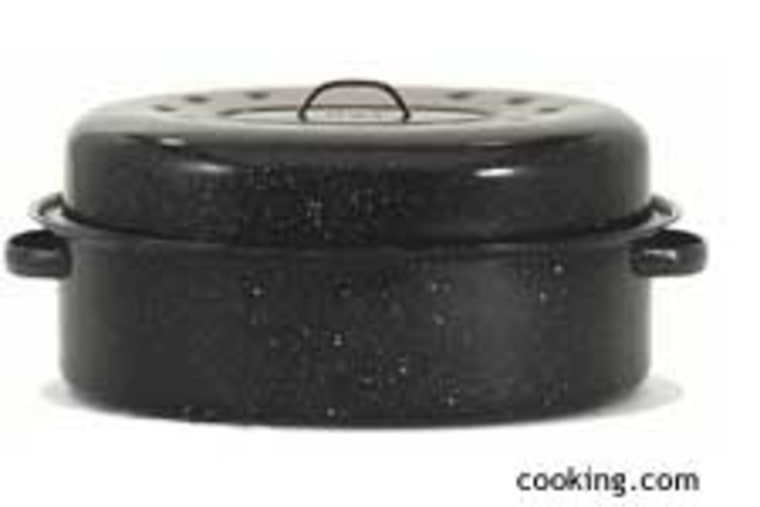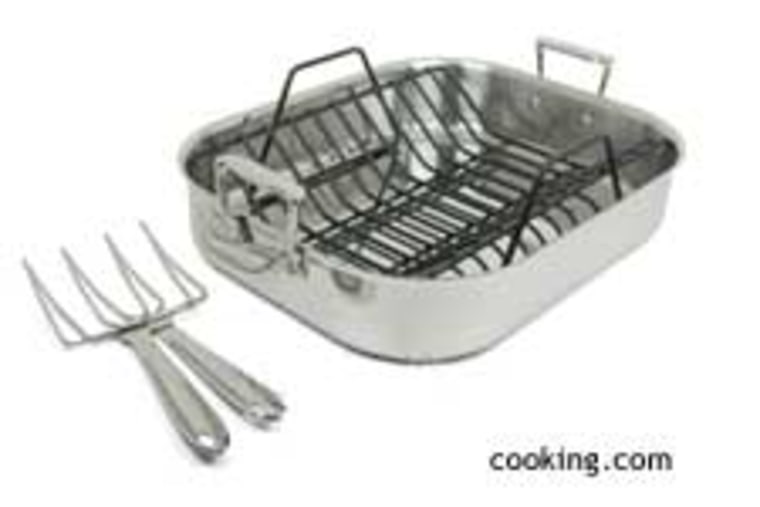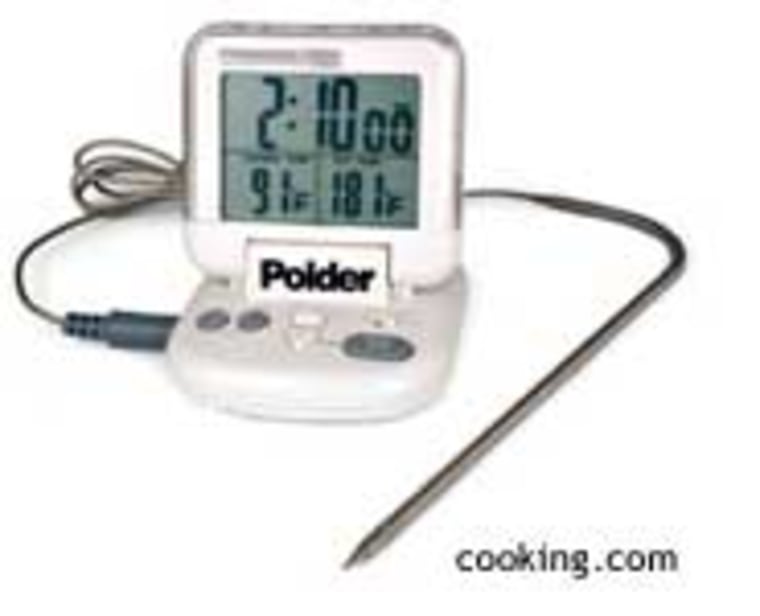It’s almost turkey time and having the right tools to roast the big bird can make the difference between a succulent meal and an unsavory one. So what cookware is essential and what tools are cool to have, or as they say, just gravy?
Unless you plan to roast the bird on a skewer on an open campfire, a roasting pan is essential. But is it necessary to plunk down the big bucks for a professional-grade roaster or will a supermarket-variety, disposable aluminum-foil pan work as well?
It’s simply hard to find a food aficionado who is a fan of the throw-away pans. “One of the best ways to make a bad turkey is use an aluminum foil pan,” says Rick Rodgers, chef, teacher and author of more than 20 cookbooks including “Thanksgiving 101” (Broadway Books, 1998). The pan buckles under the weight of most birds, says Rodgers. The sides of the pan are also too high for “proper heat and air distribution,” he adds.
Most turkey connoisseurs recommend that consumers buy the best roaster they can afford. But that doesn’t mean it has to be professional grade.

A great starter roaster is the old-fashioned, white-speckled black or navy enamel-on-steel roasting pan with a lid, says Matt Bunn, who buys cookware for one-stop cyber shop cooking.com. A common find in your grandmother’s kitchen, the vintage-style roaster requires a lot less basting than birds cooked in roasters without lids, he explains. The lid essentially “locks in the moisture,” he says. Cook the turkey in the pan with the lid on and about 10-15 minutes before it’s done, take off the lid. The 19-inch roaster at cooking.com holds up to 17 ½ pounds of poultry and retails for $19.95.
Most professional-grade roasters come without a lid and require frequent basting, says Bunn. At the low-end of the professional-grade roasters is Calphalon. These pans are made of a specially treated aluminum called anodized aluminum, which is 30 percent harder than stainless steel. The result is extremely durable cookware. Aluminum is also a better conductor of heat than stainless steel, which many high-end pans are made of, says Bunn.
Calphalon roasters come with traditional or nonstick interiors. Bunn prefers the sticky kind because some of the drippings, which stick to bottom of the pan — and he refers to as “the brown bits” — make the most flavorful gravy.
Cooking.com stocks both the traditional and nonstick Calphalon roasters, which cost $69.99 and $79.99 respectively. Calphalon nonstick roasters can be found for as little as $39.99 at target.com, amazon.com, kohls.com and cutleryandmore.com.

If Calphalon is the Cadillac of roasters, All-Clad is the Rolls Royce. For cooks who still prefer to cook on stainless steel — aluminum got a bad rap in the second half of the 20th century — most All-Clad pans have a stainless steel interior with an anodized aluminum or stainless steel exterior. The exterior is a matter of taste, (no pun intended) says Bunn. Anodized aluminum is matte gray in contrast to stainless steel, which has a shiny silver surface. Sandwiched between the exterior and interior is an aluminum core, the better conductor of heat. Cooking.com and williams-sonoma.com stock All-Clad roasters, priced from about $159-$199.
The right rack and thermometer
Another essential turkey tool is a rack. The reason is simply — you’re dealing with “25 pounds of bird,” says Rodgers. A turkey can be up to five times the size of a chicken. As a result, one turkey can produce up to five times the amount of juices as a chicken. Put a chicken in the oven and in about 1 ½ hours, it will be done, says Rodgers. A turkey can stay in the oven for about six hours. Without a rack, the bottom of the turkey stews in the juices and cooks faster than the top. A rack helps distribute the dry heat around the bird. Racks come with roasters or are sold separately.
A meat thermometer is also essential. Some turkeys come with “pop-up” thermometers that supposedly “pop-up” when the turkey is done. But these thermometers are not always reliable.
An old-fashioned meat thermometer or an instant-read thermometer runs only about $10 and are well worth the investment. The old-fashioned variety, which has a long metal stem and a dial read-out, stays in the turkey from start to finish. Instant-read thermometers are used to record the temperature periodically.
Both have minor problems. “The old-fashioned thermometer leaves a hole in the turkey and you lose some of the juices,” says Rodgers. The instant-read thermometers have thinner stems and make smaller holes but they can not be left in the oven. The lens on the read-out dial is usually made of plastic.

New, cool and slightly more expensive are probe thermometers with digital readouts. The probe is inserted into the turkey. A cord from the probe connects to a monitor with a digital read-out. The monitor sits outside the oven. Cooking.com has a programmable thermometer with timer for $25. Williams-Sonoma makes its own thermometer, also priced at $25.
The crème de la crème of meat thermometers is the remote cooking thermometer. That’s right — it’s a digital read-out thermometer with a remote device that lets turkey chefs wander up to 100 feet from the oven and still have a read on the turkey’s temperature. So kick back, watch the game or the parade, and let the turkey roast. A beeper will let you know when it’s time to return to the kitchen. Remote cooking thermometers cost from $39.99 at bedbathandbeyond.com to $49.99 at sharperimage.com.
Rodgers also would put an oven thermometer on his list of essentials. An oven can be off 25 degrees either way and that makes a big difference when roasting a turkey.
Basters, lacers and cheesecloth
Basters are technically not necessary — my mom used a spoon. But they are incredibly helpful and relatively inexpensive. Ten bucks buys a fine baster. Basters are sold at most house-ware stores. Oxo makes a bulb baster that has a flat bulb, which helps prevent it from rolling off the kitchen countertop.
Bunn strongly recommends having a fat separator — arguably not an essential — on hand. The cup-shaped device with a spout separates the high-caloric fat from the flavorful gravy, says Bunn. The fat raises to the top and the turkey juices to the bottom. Separators run as little as $5.99 at thekitchenstore.com to as much as $18.95 at cooking.com.
Turkey lacers — long thin needles used to close the cavity of the bird — are completely unnecessary, says Rodgers. “The only reason to sew up a turkey is to keep the stuffing moist,” he says. “Just put a piece at tin foil at the opening of the turkey… it works better,” he suggests. (Just in case, a six-pack of M.E. Heuck & Co. lacers cost 99 cents at bedbathandbeyond.com.)
Cheesecloth, soaked in butter and used to keep the turkey moist, is also a waste of time, says Rodgers. His only experience with cheesecloth was it ended up sticking to the bird.
Martha Stewart probably would disagree. At marthastewart.com, the turkey 101 kit not only comes with extra-heavy cotton cheesecloth but also has turkey frills — those ruffled curled paper strips used to decorate the end of the turkey legs.
Teri Goldberg is MSNBC.com’s shopping writer. Write to her at personalshopper@msnbc.com